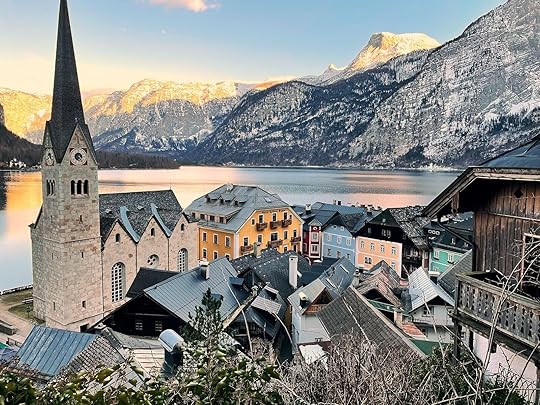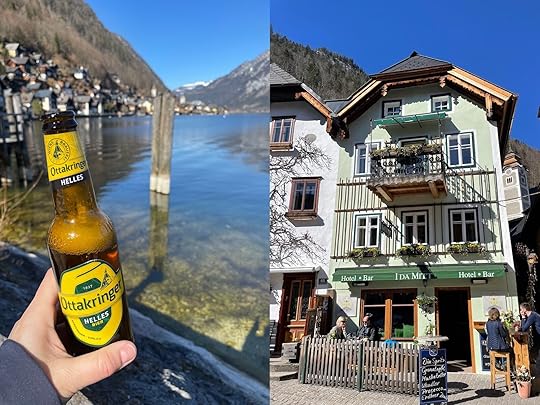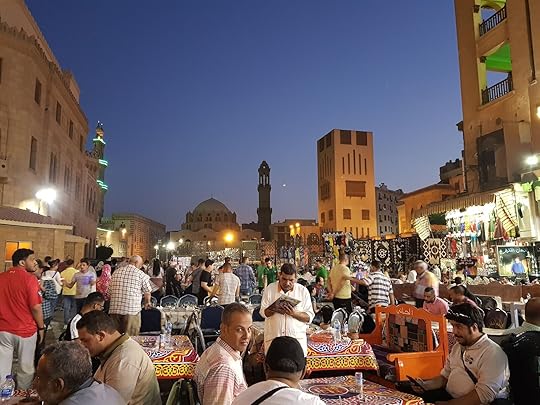Matador Network's Blog, page 505
March 30, 2022
Hallstatt Is a Picture-Perfect Austrian Getaway. Here’s How To See It Without the Crowds.

Even if you don’t know the town of Hallstatt, Austria, you’ve probably seen pictures of it. It’s the picture-perfect definition of a charming European village.
No, seriously. Do an image search for “charming European village” and the lakeside town that pops up, well, that’s Hallstatt.
Unfortunately, the word is out that Hallstatt is drop-dead gorgeous, and it has a serious overtourism problem — at least between the hours of 10 AM and 6 PM, when the combination of trains and a ferry allow daytrippers from nearby towns like Salzburg to arrive in droves. That brings an insane amount of tourists to the town of around 850 people, resulting in tourists walking through the yards of private homes and locals unable to get in and out of town without 45-minute delays.
This creates a challenge: how does a tourist get to see the gorgeous town without contributing to the problem? Simple: go in the off-hour. Here’s the perfect guide to 24 hours in Hallstatt — a UNESCO World Heritage Site — with a special focus on avoiding crowds and experiencing the town with a little more space to yourself.
Planning and logistics for Hallstatt
Photo: Suzie Dundas
When to go to HallstattSummer is by far the busiest time for tourism in Hallstatt, so consider going in winter (it’s close to ski resorts) or in the shoulder season (November or March) if you really want to avoid crowds. I visited in March, and while days were sunny and in the 50s Fahrenheit, mornings were quite cold — it really felt like I was tucked away in the mountains.
However, more important than when you go is what time you go. I can’t stress enough what a better experience you’ll have if you do the opposite schedule from most people: arrive in the late afternoon, spend the night, and spend the next morning and afternoon there before leaving that afternoon. You’ll be able to see the major sights in town well before the first tourist ferry arrives for the day.
How to get to Hallstatt from Salzburg or Munich
It’s a very short walk from the train station to the ferry. Photo: Suzie Dundas
As long as you don’t mind a few fast and easy train rides, the journey is quite easy. From Munich Central Station, you’ll first take the train to Salzburg, then swap trains to get to the town of Attnang-Puchheim, where you’ll get another train to Hallstatt station. The Hallstatt train station is across the lake from the town, but the ferry station is about 50 yards from the train station, and its timing mirrors the train’s timing. So the ferry will almost always be sitting there when you get off the train. A round-trip ticket is about €5.
Where to stay in Hallstatt
My view from the Bräugasthof Inn. Photo: Suzie Dundas
Keep it easy: stay at the Bräugasthof Hallstatt. It has only seven rooms and is in an old brewery building from the 15th century. It’s on the water and is one of the closest hotels to the town center. My room had a small private balcony overlooking Lake Hallstatt and the complimentary breakfast is in an adorably charming dining room. It’s about $150 a night and runs a beautiful outdoor restaurant in the summer and fall.
Another convenient (but pricier) option is the larger Hotel Gruener Baum, with more luxurious but slightly more corporate-looking rooms. Both hotels are within a 10-minute walk of the ferry terminal and are easy to reach while towing luggage. The town also has plenty of apartments and guesthouses (gasthaus) for rent at rates more comparable to hostels.
We hope you love the Hallstatt hotels we recommend! Just so you know, Matador may collect a small commission from the links on this page if you decide to book a stay. Listed prices are accurate as of the time of publication. See our full Advertiser Disclosure here.
Your perfect plan for 24 hours in HallstattDay 1: Afternoon/evening
A nearly empty Hallstatt after the last ferry. Photo: Suzie Dundas
Plan to arrive in town by around 4 PM, and ideally, a bit earlier in the middle of winter when days are shortest. That’ll allow you to check into your hotel, drop off your luggage, and still have a few hours of daylight left. All overnight guests to Hallstatt get a tourist card, which comes with discounts on attractions and stores, so pick that up when you arrive from your lodging.
Immediately after you’ve arrived is a great time to take some photos or swing by a local cafe for a coffee or beer (or both) to celebrate the end of a (probably) long journey. You could also stretch your legs on a hike to the Wasserfälle Hallstatt (Hallstatt waterfall). Daytrippers will be on their way back to town, so you likely won’t encounter too many people heading in the same direction on the trail. It takes just over an hour each way, give or take, for fit hikers. Afternoons are also a great time for a boat rental, especially if you catch the golden hour light. Boat rental rates are shockingly affordable, starting at about €10 an hour.
Have dinner in town. While reservations can’t hurt, the crowds go way down after the daytrippers have left, even in the summer. Have dinner in a traditional restaurant like Gasthof Zauner or Seehotel Gruner Baum (outside the hotel). Hallstatt isn’t a late-night place, so while you can certainly hang out and have a few Austrian beers, don’t plan on a super late night.
Day 2: Morning
Hallstatt at around 6 AM. Photo: Suzie Dundas
The morning of day two is when you’ll really start realizing how well you’ve maximized your time. Wake up early (a little before sunset) and walk to the Hallstatt photo viewpoint, from which the town’s most famous photos are taken. It’s usually packed with tourists, but it’s relatively empty first thing in the morning, which also happens to be when sunlight is just starting to shine on all the buildings as the town faces east. It’s a 10-minute flat walk from downtown.
Afterward, come back and have breakfast at your hotel or grab a verlängerter (similar to an Americano) and a schaumrollen (cream pastry) at a cafe like Taglich Frisch Gebacken. After breakfast, hightail it to the town’s most popular tourist attraction: the salt mine atop salt mountain (called Salzburg, like the city). The trip starts with a quick ride up a funicular (though you can also hike up in about an hour). At the top, head straight to the starting point for the world’s oldest salt mine. The surprisingly exciting tour takes about 90 minutes, which includes several chances to ride a slide deep inside the mountain.

Photo: Suzie Dundas
After touring the mine, walk around the trails at the top, taking in the fabulous views of the Alps from the Skywalk. I also recommend having a coffee at the cafe on top (Rudolfsturm), which has equally great views and reasonably priced coffees and sandwiches. It’s best to be on the first tour of the morning, and if you’re visiting in the off-season, expect quite small crowds. The tour can normally accomodate up to 70 people, but mine had three.
Day 2: Afternoon
The view from Hallstatt’s small cemetery. Photo: Suzie Dundas
If you didn’t have lunch at the Rudolfsturm by the salt mine, head back to town and grab a casual lunch to enjoy outside. Burgerman: the Station has excellent burgers and sandwiches (plus veggie options) near the entrance to the salt mine funicular, and you can walk just a few steps to sit and enjoy your meal on the water. Simple 169 is an affordable local cafe, and Maislinger sells all types of Austrian chocolate, breads, coffees, beers, pastries, pretzels and more, in case you’d like to put together your own traditional picnic.
It’s around this time you’ll probably start to notice the tourists in town, so head to one of the lesser-known attractions — nearly all visitors head to the Salt Mine and Skywalk first. Walk just up the hill behind town to visit the Ossuary Chapel, a petite church filled with more than 1,000 painted human skulls. Or keep learning about Hallstatt’s history by visiting the Hallstatt Museum or taking a walking tour; you can pick up a map of the more than 20 historical signs around town at the Hallstatt Visitors Center. Afternoons are also a great time to browse the various shops in the town, especially the high-end craft ones that can feel a bit awkward if you’re the only customer when you walk in. You won’t ever be the only customer on an afternoon in Hallstatt. Oh, and there’s a free archaeological exhibit you can visit in the basement of the Janu Sport Shop.

Photo: Suzie Dundas
And one more suggestion: if it’s sunny, you’ll find no shortage of places to post up with a local Austrian beer.
Day 2: Evening
Some of the best shots of Hallstatt are from the town’s ferry or piers. Photo: Suzie Dundas
Time to take a final few photos from the ferry as you say goodbye to Hallstatt and head to your next destination. The Austrian train system is exceedingly efficient and from Hallstatt, it’s easy to get to Munich, Salzburg, Vienna, or cities even farther afield. The OBB train system has reliable Wi-Fi and a cafeteria car, so you can check your email and drink a coffee (or both). You can choose from second, first, or business class (business class is the nicest) and you can pay extra to reserve your seat in first class if you’re worried about making sure your group can sit together.
Tips for visiting Hallstatt
Pretty neat, eh? Photo: Suzie Dundas
Unless you speak German, download the Google Translate app and download German (yes, you can download the entire language to your phone). This will allow you to translate everything from signs to menus to museum displays in real-time using your phone’s camera. Just hover over the text and it’ll translate it on your screen, though you can also take photos and upload them to the app, which may save a little more battery. As long as you downloaded German, you’ll be able to read anything you want, even if you don’t have service.
I’d advise buying your round-trip ferry ticket when you head to Hallstatt. It doesn’t save any money, but it saves a bit of time and ensures you can walk right onto the ferry for the return trip without having to dig our your wallet again.
Use an app like AllTrails or GoogleMaps to download a map of Hallstatt if you plan on taking any of the area hikes. The trails are easy to follow, but if you’re curious about how much farther you have to go, you may appreciate being able to look at your exact location.
Finally, I’d advise taking a photo of the ferry schedule and map posted at the entrance to town. You’ll be able to pick up maps at the tourist centers, but having the ferry schedule handy is quite helpful. You only need to arrive at the ferry terminal a few minutes before departure. 
More like thisCulture7 Austrian Villages That Are Just as Beautiful as Hallstattto
Switzerland’s ‘Choco Pass’ Is the Dream Ticket Chocolate Lovers Have Been Waiting For

Calling all chocolate lovers! Switzerland should be high up on that list when planning your next vacation. The city of Geneva has just launched its new Choco Pass.
Switzerland rivals Belgium as one of the best places to taste chocolate in the world with the Lindt House of Chocolate in Zürich, just a few hours away by car or train. And now, for just 30 Swiss Francs ($32.49) for adults and six CHF ($6.50) for children you can try sample plates from some of the best chocolatiers in the city. It’s worth making a day out of grabbing all the chocolate morsels, as the Choco Pass lasts just 24 hours from when you walk into your first chocolate shop.
Here’s what you’ll get to enjoy from each of the seven chocolate shops on the list:
La Bonbonnière Chocolaterie et Chocolate Bar: A choice of Grand Cru or Gourmand hot chocolate and four chocolates of choice/ Kids: A choice of Grand Cru or Gourmand hot chocolate for kids and one chocolate of choiceChocolaterie Canonica: a praline tasting plateChocolats Favarger: Avelines and Nougalines, a chocolate bar / Kids: lollipop and Avelines.Du Rhône Chocolatier: A selection of 6 chocolates featuring milk and dark chocolate and pralines/ Kids: chocolate blocks and trufflesStettler: 1 Pavé de Genève, Bonbons Deluxe range: a Chuao, a luzern, a brazilia, a fleur de sel, a raspberry pearl (in a box of 6)/ Kids: 50gr of crunchy hazelnutsSweetzerland: Caramel Truffle, Hazelnut Rocher, Raspberry Truffle, Almond Dragées, Cashew Nut Petals / Kids: chocolate almondsZeller Chocolateriers: 3 pavé glacé, 1 Florentine (milk or dark), a praline nougatine mold (dark or milk), a candied orange covered in chocolate/ Kids: a mouse with chocolate mousse fillingTo purchase a Choco Pass, visitors can buy one online or at the Tourist Information Centre, Quai du Mont-Blanc 2. So get ready to satisfy your sweet tooth! 
From Swim Up Bars To Bottle Service, These Las Vegas Spots Elevate the Sports Bar Experience

In less than five years Las Vegas has transformed from an “anything-goes” gambling and drinking haven to a bonafide “anything-goes” gambling, drinking, and sports town. What hasn’t changed is that the neon lights in the desert are a beacon for visitors looking to blow off steam (and lose a bit of coin) by offering vices on demand. And just like everything in this town, Las Vegas sports bars take watching the game to a whole new level.
Now, with the eyes of the sports world on Las Vegas thanks to an influx of professional teams, sports fans are wondering what the city has in store for them when they visit Sin City. That’s why Las Vegas’ sports bars are raising the bar when it comes to what’s expected from a first-rate establishment.
So, what’s the big deal with Vegas sports bars? How are these establishments any different from any run down place with buffalo wings? We’re so glad you asked.
Stadiums with swim-up bars, live DJs that pump up the crowd during commercial breaks, sports bars that can put the best nightclubs to shame, hundreds of selections of craft beers, the largest humidor in the city (perfect for cigars), a 4-foot long stromboli, and the hottest spots where celebrities pop up regularly. Las Vegas isn’t known for being subtle when it comes to making its sports bars the stuff of legend and ensuring guests leave with unforgettable stories, even if you’re not a sports fan.
Whether you and your posse want to hit the Las Vegas Strip, grab a pint while watching the Bellagio Fountains, or talk trash with locals in a true hometown setting, there’s a Vegas sports bar that you can turn to scratch that itch.
Does half your group want to shop in some of Vegas’ famous shopping malls while the other half watches the Dallas Cowboys lose again? Las Vegas has a place for that. Want a place to catch Premier League games at 4 AM while downing a hard cider with a bar full of other futbol fans? Yeah, Vegas has that, too.
These Las Vegas sports bars don’t want you snacking the same old fried pub snacks while sipping a flat beer, either. Here you’ll get premium bottle service, pool side table games where you can gamble, hundreds of craft and seasonal brews, nachos piled to the ceiling with toppings, and celebrity chef inspired spins on traditional sports bar foods.
Like most popular places, you’ll want to plan ahead with your group to make sure reservations are made because the best of the best fill up fast and you can lose your spot if you’re not careful. Vegas waits for no one. Here are 10 sports bars to visit on your next trip to Vegas.
Stadium SwimView this post on InstagramA post shared by Stadium Swim (@stadiumswim)
Stadium Swim is a massive rooftop pool that combines sports, swimming, and a day club to create one of the most unforgettable experiences in the world. Tourists and locals alike soak up the sun at six different pools spread out over three levels while taking in the biggest games on a 40-foot, 14-million pixel high definition screen that airs the hottest games, and betting information all day. Swim-up bars, a live DJ, pool side table games, and betting make it an all day (and night) experience. Premium bottle service and a food menu (which includes items like lobster corn dogs and a charcuterie board) that rivals many of the city’s best restaurants top off this incredible experience.
Book your cabana online and as early as possible because when Vegas heats up Stadium Swim gets extremely popular.
Where: Circa Resort & Casino, 8 E Fremont St, Las Vegas, NV 89101
Pub 365Since opening in 2016, Pub 365 has topped the Las Vegas Review-Journal’s annual Best of Las Vegas listings and it’s easy to see why. This locals-favorite Las Vegas sports bar has a rotating selection of 365 craft beers (including rare, specialty brews) and a mouth-watering selection of pub-style fare plus modernized bites like carne asada fries, pulled pork sandwiches, and an especially delicious burger topped with shrimp and queso fundido.
Download the Pub 365 app to earn rewards for each new beer you and your friends try.
Where: Tuscany Suites & Casino, 255 E Flamingo Rd, Las Vegas, NV 89169
Born and RaisedView this post on InstagramA post shared by bornandraised_lv (@bornandraised_lv)
Born and Raised is a towering figure among local Las Vegas sports bars. It’s a locals spot off the Las Vegas Strip where visitors can scream like banshees as they cheer on the UNLV Runnin’ Rebels. While you’re fisting bumping your bros with one hand, the other will be full with the succulent loaded sliders, sriracha wings or any of the 20 beers on tap.
Two locations give your group options, but you’ll want to hit the original on South Cimarron to get a real experience of rubbing elbows (and trading sports stories) with the hometown folks.
Where: 7260 S. Cimarron Road, Las Vegas, NV 89113
Beer ParkView this post on InstagramA post shared by Beer Park Las Vegas (@beerparklv)
Not only is Beer Park a beautiful rooftop bar with stunning views that overlook the Bellagio Fountains and the bright lights of the Las Vegas Strip, it’s also a sports fan’s dream. Visitors can choose between the 9,000-square foot outdoor deck or the 10,000-square foot indoor bar setting while deciding from over 100 beer selections (36 on draft) and a delicious food menu. This is a perfect place to sit, relax, take in the scenery, and catch your favorite games. When programs such as ESPN’s SportsCenter and other national programs decide to air live from Vegas, this is the place they often choose.
Guests will be thrilled to use the betting window for placing their wagers so they don’t have to leave the party to visit the sportsbook.
Where: Paris Las Vegas, 3655 S Las Vegas Blvd, Las Vegas, NV 89109
Montecristo Cigar BarVisitors who want an upscale experience to take in the best games while selecting from over 1,000 of the finest cigars and an extensive liquor menu should look no further than Montecristo Cigar Bar. Montecristo is home to one of the largest humidors in the city (over 400-square feet) and a 208-inch video wall with screens placed throughout the bar. Leather couches and oversized armchairs around out the luxurious experience.
Montecristo Cigar Bar boasts a state-of-the-art ventilation system and well-appointed decor, so even the folks in your group that don’t care for the game (those people exist?!) can enjoy themselves in comfort.
Where: Caesars Palace, 3570 Las Vegas Blvd S, Las Vegas, NV 89109
Money, Baby!View this post on InstagramA post shared by Money, Baby! (@moneybabylv)
Have you and your friends ever been in the club and wished you could sit down to watch the game? That’s Money, Baby!. It describes itself as a “high-energy and high volume sports venue” that features a combination of restaurant, sports viewing, nightlife, and interactive games in one. Your head will be on a swivel as your eyes try to digest 200 high-definition televisions, while a live DJ pumps music into the setting during commercials. Money, Baby! also features a betting window, golf simulator, and a patio that overlooks the pool. The food will impress you, too: Food Network chef Beau MacMillan crafted the menu.
Where: Virgin Hotels Las Vegas, 4455 Paradise Road, Las Vegas, NV 89169
Crown & AnchorCrown and Anchor is a classic British-style pub that is open 24 hours, catering to both early risers and night owls. It offers traditional pub fare like cornish pasty, bangers and mash, and kidney pie. Guests can also choose from more than 30 beer and cider selections. Where Crown and Anchor really shines for sports fans is its commitment to being one of the best places in Vegas to watch futbol. When important Premier League or La Liga games are being played the place becomes a madhouse. Of course, American football and local games can be watched here also, but there’s nothing quite like a group of futbol fans screaming like lunatics at 3 AM.
Crown and Anchor have two locations off the Strip but the location on East Tropicana is the spot you’ll want to hit to get the full sporting experience.
Where: 1350 E Tropicana Ave, Las Vegas, NV 891199
BlondiesYes, Blondies is in the middle of the Miracle Mile Shops so it might not catch your eye at first glance, but it’s got more than 60 high definition televisions (including a 12-foot monster) that offer great views of the hottest games no matter where you’re sitting. Then there’s the unmissable happy hour (all-you-can-drink for $20) and you’ll wonder why this place is in the middle of a shopping mall and not perched on Mount Olympus with other legends and gods.
Being inside the Miracle Mile Shops means foot traffic is high, so you’ll want to reserve a table in advance or you could be on the outside looking in.
Where: Miracle Mile Shops (Planet Hollywood), 3663 S Las Vegas Blvd #183, Las Vegas, NV 89109
TAP Sports BarIf you want to truly immerse yourself in the game, TAP has you covered with 60 high definition flat screen TVs and local brews that dominate the taps. Plus, you and your group will have the opportunity to soak in the walls full of sports memorabilia that celebrate history from some of the greatest athletes that have ever lived.
TAP is just a short walk from the MGM Grand sports book so you can smash a steakhouse sandwich then waddle off to place your bets.
Where: MGM Grand, 3799 S Las Vegas Blvd, Las Vegas, NV 89109
Tailgate SocialView this post on InstagramA post shared by Tailgate Social (@tailgatesociallv)
Located off the Las Vegas Strip inside Palace Station Hotel and Casino, Tailgate Social is a sports bar that serves up heaping portions of American comfort-food. This is a true suds and sports haven that caters to locals but is a favorite stop among tourists because of the wonderful service, beer selections, and more than 30 televisions airing both local and international sports all day.
The Holey Moley Big Ass 4 Foot Stromboli has to be seen to be believed. You and your group can tackle this bad boy or you can go it alone (as long as you bring someone to help you get back to your room).
Where: Palace Station Hotel & Casino, 2411 W Sahara Ave, Las Vegas, NV 89102 
The 11 Best Scottsdale Airbnbs With Pools for Groups and Golf Escapes

The desert city of Scottsdale entices families with its mountain vistas, hiking trails, golf courses, and endless sunshine. Equally so, Scottsdale is carving a name for itself as a leading destination for luxury resorts and spa retreats. This is our selection of the best Airbnb Scottsdale homes for small groups, large groups, and families seeking rest and relaxation.
We hope you love the Airbnb Scottsdale rentals we recommend! Just so you know, Matador may collect a small commission from the links on this page if you decide to book a stay. Listed prices are accurate as of the time of publication. See our full Advertiser Disclosure here.
Best Airbnb Scottsdale rentals for smaller groupsFine, flavorful home with fun backyard
Photo: Airbnb

Photo: Airbnb

Photo: Airbnb

Photo: Airbnb
Located in North Scottsdale, this funky family home is beautifully appointed with rustic furnishings and artistic decor. The front room is kitted out with a giant chess board for family game nights while multiple TVs are on hand when a Netflix binge is in order. Comprising one king room, a queen room, and a twin, the space is appropriate for families and friendship groups. Best of all, the outdoor area features a swimming pool and barbecue area with ample space to stretch out.
Six guests, three bedrooms
Price: $430 per night

Photo: Airbnb

Photo: Airbnb

Photo: Airbnb

Photo: Airbnb
This stylish vacation letting sits near the foot of Shadow Mountain in the peaceful North Scottsdale. A spacious open-plan kitchen, diner, and lounge is perfect for sociable groups who want to natter late into the night. The interiors are lovingly appointed with classic wooden floors, granite countertops, faux-fur throws, and fashionable linens. Your outdoor sanctuary features a swimming pool, firepit, barbecue, and foosball table.
Six guests, three bedrooms
Price: $260 per night

Photo: Airbnb

Photo: Airbnb

Photo: Airbnb

Photo: Airbnb
Yee haw, this Mexican-inspired hacienda with a Wild West-themed bunkhouse is one of the most unique holiday homes in the Southwest. Interiors are modeled on a traditional ranch with vintage cowboy furniture and wooden ceiling beams. In addition to the master bedroom, the family rental has a bunk bed that can accommodate three. Kids will actually look forward to bedtime once they see the cowboy-inspired get-up. The property is set across two acres in North Scottsdale and provides three patios each fitted with a beautiful fireplace.
Five guests, two bedrooms
Price: $145 per night

Photo: Airbnb

Photo: Airbnb

Photo: Airbnb

Photo: Airbnb
Tucked away in an upscale gated community in Grayhawk, this sleek four-bedroom residence marries practicality with beauty. The open plan living quarters manage to achieve a cozy vibe thanks to chunky leather sofas, exposed brick walls, and a roaring fireplace. The master bath delights with a spa bath while the yard is fitted with both a Jacuzzi and swimming pool. Handily located for local hiking trails, you can look forward to a day of exploration followed by a barbecue session or game of pool with your own billiards table — the perfect Airbnb Scottsdale signature.
Eight guests, four bedrooms
Price: $540 per night

Photo: Airbnb

Photo: Airbnb

Photo: Airbnb

Photo: Airbnb
Occupying a prime spot in Fountain Hills, this family-friendly holiday pad spoils you with views of the Superstition Mountains. The place features two king bedrooms appointed with sturdy wooden furniture and timber ceilings. Bedroom three contains a twin bunk bed plus a sofa bed and can comfortably sleep four kids.
An ample desert-themed lounge spills into a fabulous kitchen with masses of amenities and appliances. The backyard of this outdoor oasis invites you to relax with a swimming pool, hot tub, outdoor fireplace, and barbecue station.
Eight guests, three bedrooms
Price: $400 per night

Photo: Airbnb

Photo: Airbnb

Photo: Airbnb

Photo: Airbnb
With two roomy lounges, three generous double rooms, and bags of outdoor space, there’s no excuse for bickering at this elegant rental in Cave Creek, Scottsdale. Step outside and you can jump into the pool, start a singalong in front of the firepit, and savor epic sunsets. Scottsdale is renowned for its golf courses but this holiday bungalow brings the game to your own tee-riffic backyard. A private putting green means that by the time check-out rolls around, your entire party will be pros.
Eight guests, four bedrooms
Price: $300 per night

Photo: Airbnb

Photo: Airbnb

Photo: Airbnb

Photo: Airbnb
This four-bedroom resort in North Scottsdale is packed with entertainment and leisure facilities. A private volleyball court brings the beach to the desert while the basketball court, ping pong table, and two-tiered swimming pool make it easy to keep on top of your cardio regime. The party continues indoors with a multi-purpose games table. A state-of-the-art kitchen is the answer after a day of playing – and relaxing – hard in this awesome family home.
Ten guests, four bedrooms
Price: $810 per night

Photo: Airbnb

Photo: Airbnb

Photo: Airbnb

Photo: Airbnb
Awash with soothing hues and classy design features this five-bedroom villa is the ultimate place to unplug. The master bedroom is affixed to its own wellness deck with a ginormous shower, jetted spa bath, and relaxation zone. Your backyard features a landscaped pool, children’s playground, spa bath, basketball court, and a fitness suite. Situated in Paradise Valley at the base of Camelback Mountain, this family estate in Scottsdale is handy for nipping downtown and into the ranges.
Twelve guests, five bedrooms
Price: $1,050 per night

Photo: Airbnb

Photo: Airbnb

Photo: Airbnb

Photo: Airbnb
You don’t need to be a celebrity to travel like one, as this pristine villa makes clear. “The Pool House” flaunts one of the largest residential swim spaces in the state – complete with its own lazy river that snakes its way around the tropical palms. Landlubbers and sporty types will appreciate the property’s basketball court, driving range, indoor games room, and cinema zone. The hosts are on hand to arrange anything you need during your stay, such as in-house chefs, massage therapists, and yoga classes. Why would you even consider going downtown?
Sixteen guests, seven bedrooms
Price: $2,760 per night

Photo: Airbnb

Photo: Airbnb

Photo: Airbnb

Photo: Airbnb
This 2.5-acre private resort in North Scottsdale revolves around a three-tiered swimming pool with a hot tub. At-home entertainment includes a ping pong table, pool table, and firepit that begs for an evening of s’mores. A vast kitchen is fitted with two islands where you can whip up meals to enjoy al fresco before flopping down in the tiered movie theater. The master bedroom – boudoir feels more appropriate – is attached to a deluxe bathing suite where you recharge in style.
Twelve guests, six bedrooms
Price: $1,580 per night

Photo: Airbnb

Photo: Airbnb

Photo: Airbnb

Photo: Airbnb
This blissful vacation compound provides all the trimmings to make you feel like a star. Lap up the mountain scenery from one of the two saltwater pools or kick back with a glass of bubbles in the hot tub. Golf fanatics can improve their technique on the backyard course while inspiring culinarians can whip up any cuisine under the sun in the top-of-the-range kitchen. Or, do as the A-listers would and dial in a local chef for the night. 
Sixteen guests, six bedrooms
Price: $1,330 per night
Traveling To a Muslim Country During Ramadan? Here’s What You Need To Know.

Ramadan comes around once every year, and it’s an additional consideration travelers may need to think about depending on what country they’re visiting. While you may have plans to travel to certain destinations that partake in Ramadan, it’s culturally respectful to fully understand what the month is and how you can be a good traveler in these countries.
What is Ramadan?Ramadan is the ninth month on the Islamic calendar and happens once a year. The tradition of Ramadan dates back thousands of years and is also the fourth pillar of Islam. During Ramadan, Muslims fast from sunup to sundown, in addition to reading the entire Qu’ran in 30-days and extending prayers. It’s considered the holiest month due to its purpose of building and seeking God-consciousness while also being a month where Muslims try to find ways to be extremely charitable, feed others, and increase their acts of kindness in words and actions. At the end of the 30-days, Muslims celebrate a three-day holiday called Eid al-Fitr, or the “festival of breaking the fast.”
What to expectRamadan is a much more subdued time of year for predominantly Muslim countries. If you’re used to the bustling energy of a country like Egypt, expect to see less people on the streets than normal. In addition, the call to prayer will be something you will readily hear five times a day over outdoor loudspeakers, which is typical for Muslim countries.
Are you expected or required to fast? No. However, if you were to ever have empathy for people, trying it out will show you just how difficult it can be for people’s sleep patterns and accomplish their normal day-to-day tasks. Understand that while these countries are majority Muslim, many are also Christian, Buddhist, and many other faiths that don’t fast for Ramadan. For destinations that highly depend on tourism, such as the Maldives, tour operators, vendors, and restaurants will operate business as usual, but plan for some business to only be in operation in the evening once the fast is broken.
How to be a respectful touristRamadan is an extremely vigorous month and in countries that are hot or humid, imagine how you’d feel fasting from food and water and still having to work through the entire day.
Here’s how to be a respectful tourist during Ramadan:
Offer grace: People will not have the same energy and vigor due to a heightened feeling of tiredness. Be less demanding and more accommodating because Ramadan is not easy, but you don’t have to make it harder.
Tip more: Many of the Muslims that are fasting but work in the service industry are showing up because you are present, so if you’d normally tip 10-15%, double it to show your gratitude.
Feed people: There are many countries where there are people much less fortunate than you who do not have the ability to get jobs that make livable wages. Ramadan is a time when everyone focuses on feeding each other to retain blessings. So if you have leftovers you may not finish or want to buy a meal for someone, that level of charity goes a long way during this time.
Follow a more modest dress code: Modesty doesn’t require you to be completely covered head to toe, but to ensure that your arms, legs, and chest are covered. This is a holy month, so if you’re out and about in the street and not on a resort, just be mindful of showing respect through how you’re dressed.
Remember, you don’t have to be Muslim to have manners and show gratitude for the privilege of traveling to places during Ramadan. Enter your travels, during the month, with patience and just be a gracious guest.
Countries that are predominantly MuslimHere’s a list of countries that are predominantly Muslim, to get an idea of expectations you should have before traveling to them:
Islam as state religionAfghanistanAlgeriaBruneiEgyptIranIraqJordanKuwaitLibyaMaldivesMauritaniaMoroccoPakistanSaudi ArabiaSomaliaTunisiaUnited Arab EmiratesYemenPopulation majority Muslim (but separation of religion and state)AlbaniaAzerbaijanBangladeshBurkina FasoChadThe GambiaGuineaKazakhstanKosovoKyrgyzstanMaliNorthern CyprusNigeriaSenegalSyriaLebanonTajikistanTurkmenistanTurkeyMajority Muslim populationBosnia and HerzegovinaDjiboutiIndonesiaMalaysiaNigerQatarSierra LeoneSudan More like thisPhoto + Video + FilmThe Profound Beauty of a Muslim Country
More like thisPhoto + Video + FilmThe Profound Beauty of a Muslim Country
March 29, 2022
Flight Prices Are Up 40 Percent Since January. Here’s How Much Higher It’ll Get This Summer.

Flight prices are rising, and they’re not expected to come down anytime soon. At the beginning of 2022, the flight and hotel company Hopper released its quarterly Consumer Airfare Index Report. We’re now going into the second quarter, and the latest report shows prices are reaching record highs.
In its Q1 2022 Index, Hopper expects domestic airfare to reach about $290 for a round-trip flight in late March before returning to pre-pandemic 2019 prices by April, with an average of a seven percent monthly increase until May. However, by the first week of March, flights had already surpassed 2019 prices and have reached 2018 prices. Airfare rose 12 percent in February and 19 percent in March. Overall, current flight prices for domestic airfare are up 40 percent — from an average of $235 round-trip in January to $330 round-trip. In the quarter two index, Hopper expects that prices will increase by another 10 percent by May, to $360 round trip. The good news is that if you can wait to travel domestically until the fall, prices are expected to gradually decline after June.
Trends show that travelers are booking domestic flights about 41 days in advance on average, down from 50 days pre-pandemic in March of 2019, but about the same as March 2021.
International flight prices also show a gradual increase, getting closer and closer to pre-pandemic levels. In 2019, a round trip ticket would run you about $830 in late March. This year’s flight prices are around $810 round trip, a 25 percent increase from the average of $650 per round trip at the beginning of the year. Prices are expected to reach pre-pandemic levels by May and then surpass them by June, reaching $940 round-trip before following the same seasonal fall trend. Travelers are booking international flights 65 days in advance, which is about the same as last year, but still down from 79 days pre-pandemic. And international seat capacity is still down 25 percent compared to pre-pandemic numbers.
Flight increases are due to a few factors. Hopper expected the price of jet fuel to increase, but the war in Ukraine has exacerbated this problem, making the price spike much quicker. Jet fuel is currently $3.07 per gallon, reaching the highest prices since January 2014. Jet fuel was only $2.20 per gallon at the start of 2022. The price spiked as high as $4.10 per gallon in early March after Russia invaded Ukraine in late February. But broad reopenings of several countries in Asia as well as Australia have caused significant traffic increases. Flight hikes have also been caused by the end of the Omicron-variant wave, but if another wave from any strand were to occur, this would drastically impact prices. 
Whale Meat Is the Controversial Dish Every Visitor To Norway Should Try at Least Once

With its idyllic waterfront location on the chic Aker Brygge-district of Oslo and its steel-and-glass exterior, Rorbua might not strike you as a seafood restaurant that pays tribute to Northern Norwegian cuisine. Named after the traditional seasonal huts used by sailors along the Norwegian coast, the reference becomes apparent once you take a step inside the restaurant. Here you will find big-game rifles hanging on the plank-wood walls and a steering helm at the bar. If you’re a curious eater who knows anything about Scandinavian cuisine, you’ll probably know that this is where to try whale meat in Norway.
What’s catching the attention of the foreign tourists and the locals on this early spring evening is the menu. A common conversation point along the tables is whether the guests have tried hvalbiff – or whale steak.
Across the national Norwegian restaurant scene, whale meat has seen a growth in demand the last couple of years, mostly due to an increasing interest in local cuisine and consumers growing tired of industrially produced meat such as pork and beef.
For many years, meat from minke whales has been considered a controversial ingredient in Norwegian cuisine. By the mid-20th century, many species of whale had been driven close to extinction. As a result, commercial whaling was banned worldwide in 1986. Norway remains one of only three countries to at least officially allow commercial whaling, along with Iceland and Japan. Norwegian governments have over the years cited cultural reasons for flouting the 1986 ban and maintain that the hunt is limited only to minke whales – a species not under threat from extinction. It is estimated that more than 100,000 minke whales live in the Norwegian and Barents Seas.
Last year, 575 minke whales were caught in Norway. Even though it is less than half the annual quota of 1,286, the number remains the largest increase in almost a decade. Hunting season starts in April and continues until the end of September.
Small fishing vessels, mounted with a harpoon cannon on the bow, are used to catch minke whales. Each harpoon comes loaded with explosives that go off once they have penetrated about a foot into the flesh of the whale. The internal blast is supposed to cause enough brain damage to kill or knock out the whale within a few seconds. Should the whale survive the grenade harpoon, the gunner will usually pick up a high-powered rifle to finish the job.
The whale, usually 22 feet in length and up to 5.5 tons, is hauled onto the vessel and is stripped of its blubber, gutted, and carved up for meat. Much of the catch is sent to the Japanese market, where the demand is high.
As the COVID-19 pandemic devastated the travel industry, whalers in Norway have reaped the rewards of a national staycation. Norwegians who would usually have traveled to Italy or Spain have instead headed towards domestic destinations like Lofoten Islands above the Polar Circle, a scenic destination, rich in sparkling fjords, jagged coastlines, and endless days of midnight sun. Here, the tradition of serving hvalbiff has been preserved for millennia and has spread across to the national restaurant scene. Now, for the first time in decades, demand for whale meat has outstripped supply.
Back at Rorbua, although the choice of food this evening resembles the varied menu cart, the majority of guests get a taste of whale. The meat from the tail fin of the whale is the most-sought after cut and is fried as a steak. The experience?
Whale meat is a much more gamey and tender version of beef, and quite chewy yet with the melt in the mouth texture of tuna. The taste is mild and somewhat similar to moose and reindeer, but contains higher nutritional values, including a high level of protein and is easier to digest. Here’s where to sample whale meat for yourself in Norway.
Where to eat whale meat in NorwayBryggeloftet & Stuene: Specializing in traditional Norwegian dishes like reindeer, fish soup topped with fresh prawns, and minke whale meat, of course, Bryggeloftet is one of the oldest restaurants in Bergen. Founded in 1910, in the historical west coast city of Bergen, Bryggeloftet prides itself on offering hearty food, and using fresh catch from the North Sea. It’s known especially for its heartfelt hospitality, and if you make a reservation, expect to be greeted by restaurant owner Inger, who enjoys a personal relationship with many of the regulars.
Where: Bryggen 11, 5003 Bergen
View this post on InstagramA post shared by Счастливая Мама
(@zhanem78)
Rorbua: Rorbua is committed to using staple ingredients of traditional Arctic circle cooking in all its dishes, especially dried seafood snacks, smoked whale meat, and unsalted stockfish. The restaurant offers a cozy atmosphere inside and a stunning view of the Oslo inner fjord, making it one of the most interesting restaurants in the Norwegian capital.
Where: Aker Brygge, Stranden 71, 0250 Oslo
Lofotmat: This little cozy restaurant is located in beautiful Henningsvær on the magnificent Lofoten Islands above the Arctic Circle. Lofotmat offers exceptional fried scallops, gratinated dry fish, duck, and whale. The restaurant sources its ingredients from local producers, including seaweed, edible plants, herbs, and fresh seafood.
Where: Dreyersgate 56, 8312 Henningsvær
View this post on InstagramA post shared by Restaurant_Lofotmat (@restaurant_lofotmat)
Dødeladen: Dødeladen has a strong connection to the sea as the building originally served as an insurance office for local fishermen, so expect to be treated to an atmosphere that feels true to the Norwegian way of life, and an extensive list of seafood delicacies. In addition to the must-try hvalbiff, the menu features classic dishes like moules marinières, dried and salted cod, baked clams, and a local version of the Portuguese bacalao.
Where: Skippergata 1A, 6507 Kristiansund 
How to become fluent in a language

The question “how to become fluent in a language?” is one that almost always gets the same answer: All you need is to work at it diligently and be armed with patience. But there is more to becoming fluent in a language than this perfunctory advice, especially if you want to do so in six months or less.
No matter the language you are trying to learn, whether it is considered to be a hard language or an easy one, there is a number of steps that will help you reach proficiency rapidly.
Although English is my first language, I learned Mandarin and Cantonese as a child, picked up French in high school, and have become conversant in Spanish while traveling through South America. Over the years, I’ve picked up a lot of tips and hacks to improve my language-learning skills. Here is how to become fluent in any language in six months or less.
1. Immerse yourself in the language you want to learnIt’s almost impossible to learn a new language, or at least to learn it rapidly, unless you begin thinking in that language. But how do you think in a new language you can’t yet speak? The answer is to simply immerse yourself in it. Traveling in a foreign country allows you to continuously hear the sounds and rhythms of a new language — spoken on the streets, in buses, on television, etc. Being in constant contact with the language, your brain will already start to process and interpret it.
Even better than simply traveling is being forced to operate in a new language by participating in a volunteer program or working abroad. Best of all is being completely immersed with locals (such as living with a host family).
Immerse yourself with the locals, their music, culture, media, politics, sports, family, etc. Integrate yourself with the community and you’re halfway there!
2. Forget translating: Think like a babyHow do babies learn language? Through imitation, repetition of sounds, and above all, by not being shy or self-conscious.
So what if your pronunciation is a little off, or you can’t remember the proper conjugation? Just start talking, even if it seems like babbling. Resisting the urge to translate everything into your native language can be the single fastest shortcut to fluency.
For example, at a restaurant, rather than using a pre-memorized phrase for what you’re going to order, simply listen to how the locals order their food, and then imitate them as best you can. The same goes for greetings, small talk, etc. Watch their facial expressions as they say the words; study how they move their mouths.
Copy these expressions and sounds just like a baby would. Whether you understand what they mean exactly or not, eventually you will begin simply calling upon these sounds / phrases / words in appropriate situations. They’ll appear, as if by magic. This is a big step in becoming fluent in a language.
3. Be curiousBesides common greetings, the one phrase you should memorize and always have at the ready is the phrase is “How do you say that / what is that called?”
By being an inquisitive traveler, one who is always asking questions, you befriend the local people. You’ll find that over time they’ll open up to you, making it easier to initiate conversations. These daily interactions with the locals are your best teachers: set a daily goal for yourself of having a certain number of conversations each day. Even if you can’t finish the conversation, you’re on the way.
4. Write down what you want to understandAfter having conversations, jot down the things you remembered hearing but didn’t quite understand. Then go back and use your dictionary. Look up the words, piece the conversation back together in your mind. Then, next time you have a conversation, use what you learned.
When studying French and Spanish, I also used “grammar sheets” where I wrote down the various verbs to learn their conjugations. Besides helping me focus, they also became handy reference guides.
5. Use cognates and draw linksEver noticed how some words appear exactly the same across various languages? These are called “cognates.” Unlocking the usage of cognates instantly gives you several hundred more words to your vocabulary.
For example, most words ending in “ion” in the Latin languages are the same in English. In Spanish, information is información, and donation is donación.
Similarly, words across different languages often share the same root word, so drawing on what you already know will make it easier.
For example, cheese is fromage in French, and formaggio in Italian.
6. Watch and listen local TV, movies, musicWatch movies, listen to music, sing songs, and browse newspapers and magazines. It’s fun and helps improve your pronunciation and comprehension.
I often stumble when trying to read Chinese script because I don’t use it enough and there are no phonetic cues in Chinese characters. But by watching Chinese music videos and following the lyrics, I learned many new characters and also began pronouncing words more accurately.
In the same way, I attuned myself to rapid French prattling by watching French movies on DVD without subtitles and improved my Spanish by paying attention during the dubbed action movies on long bus rides in South America.
Salsa classes have also ensured I know my izquierda (left) from my derecha (right)!
7. Observe non-verbal cues and imitate themBeyond words, observe locals when they talk. Be it the Gallic shrug or a slight tilt of the head, combining body language with a new tongue helps you communicate better.
This is especially important in cultures where language is closely linked to gestures. For instance, appropriate bowing and greeting in Japanese are inseparable, as with the hand gestures and intonation in Thailand.
8. Get emotional to better rememberEmotive experiences often etch impressions onto our memory. Make full use of embarrassing / funny / angry experiences by linking them to the new language.
I learned, quite unfortunately, the importance of the special “ñ” character in Spanish because saying “Tengo 24 anos” instead of “años” meant I told everyone I had 24 anuses rather than being 24 years old.
Needless to say, the embarrassment helped correct my pronunciation for good!
9. Practise with friends before going soloWhile individual classes can be highly beneficial for unsurpassed attention, group classes with friends can greatly aid learning. Having a friend to practice with helps you get better, and you can also learn from the different mistakes different people make.
On the other hand, venturing out solo in a foreign country forces you to speak with local people — say the person riding next to you on the bus, or standing in line at the market. It also prevents you relying on a friend with stronger language skills to do the talking for you in key exchanges such as asking for directions or buying food.
10. Practice at every opportunity before and after you travelEver felt “rusty” and lacking confidence in a language despite having taken classes or used it (or even mastered it) at some other time in your life? Languages are alive and require exercise. Find avenues to practice wherever and whenever you can. 
New Poll Finds America’s Favorite Road Trip To Take in the United States

When you live in the United States, there’s no need to get on a plane to enjoy natural wonders, attractions, or fantastic food. An all-America road trip is an excellent opportunity to immerse yourself in all the country offers. Whether you’re going cross country to see some (or all) of the nation’s national parks or plan a road trip around wineries, driving can make for the perfect adventure.
Over the last few years, road trips have become more and more popular. And some people have strong opinions about their favorite routes to travel. Branded Research, a company that assists with polls and research, conducted a poll with Matador Network that a surveyed 27,050 people in the US to find the best road trip that crosses at least two states.
Here are the cross-country road trips, ranked by the percent of people who voted that particular route as their favorite.
The best road trips across the United States:Route 66 from Chicago to Santa Monica: 31.1 percentPacific Coast Highway from Seattle to San Diego: 25.2 percentBlue Ridge Parkway from Shenandoah National Park to the Great Smoky Mountains: 17.8 percentThe Oregon Trail from Cannon Beach, Oregon, to Provincetown, Massachusetts: 7.2 percentThe Southern Pacific on I-80 from San Diego to Savannah, Georgia: 7.1 percentGreat River Road National Scenic Byway from Park Rapids, Minnesota, to Venice, Louisiana: 6.3 percentThe Great Northern on Route 2 from Seattle to Augusta, Maine: 5.3 percentThere were some interesting trends looking at the demographics. Men have a greater preference for Route 66 at 34 percent, compared to 29 percent for women. There’s almost a 10 percent difference in men’s love for Route 66 over Pacific Coast Highway (PCH), but there was only about a five percent difference for women. However, older consumers overall prefer the PCH. Thirty percent of consumers aged 65 and older ranked the PCH as their favorite, versus 26 percent for consumers aged 45 to 64, 24 percent for consumers aged 25 to 44, and 21 percent for consumers under age 25.
It makes sense that the iconic Route 66 is so popular with stretches of Route 66 in Texas alone featuring destinations like Caprock Canyons State Park or the colorful art installations at Cadillac Ranch. However, if you decide to enjoy PCH over Route 66, there are plenty of campsites along the way to stop and enjoy California’s beauty. While you may be tempted to spend all your time on the PCH in California, don’t forget to enjoy some of the prettiest beaches in Oregon and Washington farther north. 
Here’s When Buying Two One-Way Flights Is Cheaper Than a Round-Trip Ticket

There are die-hard travelers on both sides of the proverbial aisle — adamant one-way warriors versus the always-reliable round-trippers. If you’ve tried to google which is better, you’ve most likely found yourself more confused than before. So let’s clear it all up once and for all — which is truly the better booking option, one-way flights or a return ticket?
Well, the truth is “it depends.” Sorry, I know that’s a letdown. But simply put, both can be the right choice depending on the situation. The large majority of travelers simply book a roundtrip ticket by default — it’s easy and people typically assume it’s cheaper, but that’s not always the case. There are a few scenarios where booking one-way travel will help save you money and make your booking more flexible.
One-way flights are better when you book with pointsA good example of when booking two one-way tickets rather than a roundtrip ticket might be favorable is when using points. Points bookings are usually dynamically priced within a range of prices, however, the number of points needed for a roundtrip ticket usually does not change if you book two one-ways instead. While this might not make the flight any less expensive, by booking two one-way tickets, it is often significantly easier to change or cancel should you decide to stay longer or leave earlier. For example, Jetblue specifically recommends booking one-way fares when dealing with points because it’s easier to update booking dates after the fact, giving you more flexibility.
Similarly, if you have points accumulated across a few airlines, you can book one-way on Airline A and one-way on Airline B. I typically do this when I don’t have enough points to book a roundtrip on a single airline’s points program, but can combine carriers to use points for the entire trip.
One-way flights can also be cheaper when you make multi-airline bookingsJust like with points bookings, sometimes booking two one-way tickets on separate airlines can save you a good amount of money. For example, if you are flying from San Francisco to Miami, you may find a great deal on United to get to Miami and there may be a great deal on American flying out of Miami. If the carrier has to move a plane and it’s not full, you may find some insane deals on one-way tickets if you’re willing to do the extra bit of work.
To find the best deals, I usually search on Google Flights for one-way tickets. You’ll see the lowest-priced flights appear first and can use extensive filtering and calendar views to find the perfect flight.
For example, when looking at the cost of a round-trip ticket from San Fransico International Airport to Miami International Airport on April 18 — April 20, you see:

Photo: Google Flights
The cheapest ticket is $439, but keep in mind you have no baggage allowance.
If you then search one-way on April 18, you find:

Photo: Google Flights
Obviously, $68 is an amazing price for a one-way ticket even without the luggage. Now, enter the return:

Photo: Google Flights
The best return ticket is $197. So in total, booking two one-way tickets would cost you $265. That’s almost half the cost of the roundtrip booking.
Return tickets make sense with flight dealsSo now that you know of a few ways to leverage one-way tickets, let’s talk about a time you don’t want to rely on one-ways.
Flight deals are an area to consider booking roundtrip tickets. Flight deals are typically based on roundtrip fares and therefore you’re not going to find the same one-way prices available. For example, I recently got a notification for a flight deal in my inbox for a roundtrip to Puerto Vallarta for under $300:

Photo: Google Flights
You can see here that a roundtrip ticket on May 9 — May 16 will set you back $264.
If you do the math on the one-way tickets, you’ll find a one-way on May 9 to Puerto Vallarta will cost you $116.

Photo: Google Flights
The return flight booked separately on May 16 will cost you $189:

Photo: Google Flights
If you book the two one-ways, you’re paying a total of $305. That’s quite a bit more than that flight deal was offering at $264.
At the end of the day, it all comes down to your willingness to spend the time to do your research. If you take the time to look into one-way ticket options versus roundtrip, you could end up saving some serious cash, and having more flexibility to extend that dream vacay. 
Matador Network's Blog
- Matador Network's profile
- 6 followers



